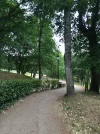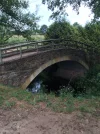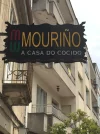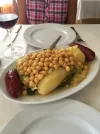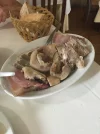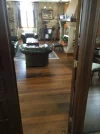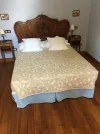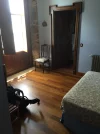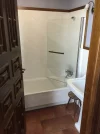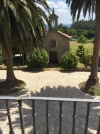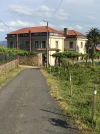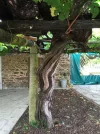Town by town notes on the Camino de Invierno, April 2016
Ponferrada
The Albergue Guiana was great. Open till midngiht. It was nice to have time for both Mass and dinner before going back to the albergue.
Villavieja
The paved road and the path through the chestnut trees both go to the entrance of the Catillo de Cornatel. The Castle is open Friday-Sunday, 11:00-2:30, 4:00-9:00, starting in March. Pilgrims walking their first day out on a day the Castle is closed may want to take the very short road detour instead of the full climb to Villavieja and the Castle to save time to visit the Orellan lookout or otherwise explore Las Medulas.
Borrenes
The store has definitely gone out of business. Casa Marisol made me a crude but ample bocadillo de chorizo and a cafe solo for 3.60 euros.
Las Medulas
The hotel was closed for the season. Socorro who rents rooms found me as I walked around town, so I stayed with her. A nice clean room and friendly breakfast for 20 euros, although I could not make the connection to her wifi.
The descent through the forest to Puente de Domingo Flores was very beautiful: spring flowers, inspiring views in every direction.
Puente de Domingo Flórez
The left turn to leave town is at the Dia supermarket.
O Barco
...is a beautiful town. It’s hard to believe it has only 10,000 people. It would be shame to skip it to rack up kms. I had a good stay at the Hostal Mayo (22 euro single), and a very good dinner across the river (first pedestrian bridge) at the Asador Viloira.
The plethora of alternatives for leaving town are a little confusing. I just walked out the main street (one block towards the river below my hotel and the Pension do Lar), the Av. Conde Fenosa (aka N-536).
A Rua
I had a great lunch (a one choice menu, but delicious) at the Meson O Toño (center of town near the Bar Pepa and Eroski supermarket.
It was a treat to meet Asun, who is head of the Asociación Amigos do Camiño de Santiago por Valdeorras. As the English-language guide notes, she is a pleasure to talk to and full of information.
Leaving town, if you come to the Maderas La Cigara lumber yard, you have gone 150m beyond the spot to cut underneath the highway and will need to double back. Or better still, once you see Maderas La Cigara on the horizon, be on the lookout for the turn and tunnel.
Alvaredos
In the rain it may be easiest to stay on the LU-933 rather than climbing to the village. I got utterly soaked on the pretty, but overgrown, grassy path out of the village, and it was a long, mushy walk thereafter. (I did get to see a surgically clean, modern winery being built on the first floor of one of the big, beautiful houses in Alvaredos. It is striking how development and decrepitude can sit side-by-side in rural villages in Galicia.)
Montefurado
The church was open on Saturday for preparing the altar for mass and there is still a Sunday mass. It was a surprise as it looked decrepit as I climbed up the hill.
The waymarked and placarded (Camino Sur) path out of Montefurado is badly, badly overgrown with foot-high grasses and wild flowers. I was really soaked after that. I think by going right after the church rather than going left and following the marked trail, you could reach the paved road to Hermidón.
Bendilló-Quiroga
To avoid the fussiness I spent about 200m along the highway to enter Sequeiros directly. I stayed on the LU-933 until just before the Castle (It’s an easy crossing of the N-120.) and then went straight downhill toward Quiroga rather than doing the (very wet!) loop back across the creek. This must have been the route at some time, because there are arrows into town. There are several big ruina montium boreholes (placarded) on the right as you head toward Quiroga.
Quiroga
The Quiroga Albergue folks were very helpful: they showed me to the laundry and the boiler room they use in lieu of a dryer, so I was able to wash and dry my clothes, and more importantly to dry my shoes.
I had an excellent dinner (fabada and homemade paella) at the bar A Taverna, and lovely, fresh pastries for breakfast from the Panaderia Marisa, opposite the albergue, which opens at 8:00 am.
Quiroga-Barxa de Lor
Although it rained a lot both this day and the previous one, the logging roads through the high hills were all well maintained and not hard to pass through.
A small correction to the English-anguage guide: the crossing of the N-120 to the derelict nightclub before Noceda is at grade, not under the highway.
A Pobra to Monforte
After a Pobra, the asphalt runs out and the the track was frequently muddy and flooded. I was afraid of getting bogged down in the mud as it got darker and doubled back to take the two-lane, pretty much uninhabited LU provincial road toward Cereixa. When it ended, instead of going right to A Cereixa,I took a left and walked for about 800m on the Avenida de Lugo and then met the LU-933 which I took into Monforte. I got there by 8:30 pm.
Monforte
I’ve been to Monforte a couple times before on my bike, and enjoyed eating at the Parador and O Grello on those trips. This time I had an equally good meal at the Restaurant Polar, right in the center of town. (About 22 euros. Every course was good, as were the baked goods for breakfast the next morning. It looks like a typical Spanish bar with a comedor, but the quality was very high.
I overslept and decided to stay for the 11:00 am mass at the chapel of the Colegio de los Escolapios. (I’ve never been able to make the tours.) A good experience, followed by shopping at the Sunday farmers market and flea market in the park next door.
Sadly, the bar as you leave town has given up the ghost.
Castrotañe-A Barxa
Staying on the LU-P-4112 was an absolute must in rainy April. (The Camino into Castrontañe is an overgrown streambed and was in full-flood.)
San Pelayo
The work on the episcopal palace attached to the Church of San Pelayo in Diamondi is now finished. The church was more than worth the short detour.
After the short concrete stretch, the next 500m of the Codos de Belesar are pure muck in spring rain. The Roman road section is better, but a little slippery in the rain.
Chantada
I arrived at 9:30 pm, but had good (and huge) dinner at the Bar Lucas and a good sleep at the Hotel Mogay.
Chantada-Rodeiro
There are a series of beautiful horreos as you leave Centulle.
Unfortunately, in April the “service road” after Centulle has several long stretches of pure mud pit and flooded roadway. The carretera is a real closed access road, 5-15 meters below the camino and beyond a fence, so it’s not really an alternative. Hopping onto fences and waterlogged fields was not much better. (I got hooked on barbed wire for the first time since my first Camino in 2004.) 50 or so cows on the road and more rain compounded the problems.
At Penasillás, I changed shoes and detoured by the alternative route laid out in the Valdeorras Amigos guidebook. Pretty, quiet, dry. Good views, although it sounds like not as good as on the direct climb. This route rises to about 775 m, descends and then ascends further to 890 meters at the Alto de Faro.
Rodeiro
I had good meal and a perfectly clean, perfectly heated room (so I could dry some critical laundry) at the restaurant and Hospedaxe O Guerra.
Rodeiro-Lalin
It poured rain the whole time, and based on fatigue and the recommendation of the restaurant owner in Rondeiro I walked the carretera service road. One of the bars on the way specializes in making honey, which made a nice change from the usual cafe stop.
I got lost trying to find the church in Lalín de Arriba and so made my way into town five or ten blocks off course. I had a nice lunch of callos and pulpo á feira at Restaurant San Martin II (opposite the Sergas clinic) and a nice pastry at a bakery-bar called Dulces Encantados (diagonally across the street from the pig monument, just below the main church).
Joining the Sanabres
From Silleda on (specifically from one block after the Nudesa plant) all the dirt roads are all reinforced with gravel and can stand up to wet weather. There were also some pilgrims about.
In Silleda I stayed in the Bar Toxa’s apartment: clean, modern, 15 euros.
The weather cleared the next day and I had the sort of day I had hoped for all along.
The Pasteleria Dulce Deza as you enter Bandeira is a good morning stop for coffee and a pastry for those who are leaving Lalin or Silleda.
Ponte Ulla
I tried the fancy Restaurant Villa Verde in Ponte Ulla. A beautiful first course of home-smoked salmon over fresh tomatoes. Second course was Roballo a Gallega. The dessert was an interesting walnut and banana torta (Torta de Nueces y Platanos.) About 42 euros with coffee and a couple of glasses of local Albariño.
For climbing to the Pensión O Cruzeiro da Ulla, note that it is up the long stairway that lies between the Camino (steep, rocky walk) and the local highway where the Dia supermarket is. The long stairway climbs up to the N-525. The pension was newish, clean and only 20 euros for a single.















